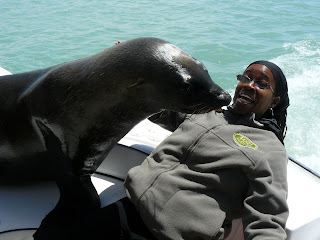




Task 1: Quad Bike Safari – Advanced Trail
When the chubby quad bike guide, flanked by his 10-year old grandson who would be joining us, “warned” that we may want to take an “easier” trail, my dad and I were both quick to opt for the “advanced” trail, statedly confident that if They could do it, We could do it. We soon learned that we were indeed in for a challenge. From the heights we scaled and the drops off the slithers of mountain they carved for the experience, to the 40+ degree inclines and declines we had to maneuver, the heat was on. I was a bit anxious for it all to end about half-way through the trip. As the guide pointed to game and wildlife to the left and right, I completely ignored him to stay focused on my path and technique. Dad did pretty good, though based on my limited understanding of the laws of physics, I was scared at least a few times that he might flip backwards when trying to manage the inclines.
Task 2: Dune Climbing
Although I hear that there are many more wicked ways to conquer the beautiful and famously-high sand dunes of Namibia (i.e. sand surfing), the basic walks up and down were enough for me. At one point, I simply chose to “de-shoe” because the pressure of the filling sands on my toes was too painful. Luckily, we had an early morning start so my feet didn’t burn along the way. I think it was pretty intimidating. Aside from the fact that walking in the sand is taxing, we were easily more than 300 feet off the ground….with an even more dune height to conquer!! You could look left and look right and see just how high you were. Plus, the shifting sands made you feel even less comforted. Topping it off, our plan was to “run” down the side of the dune to get back to the valley floor. Even though individuals looking to be much older than my father walked around me at a few points on the dunes’ vertices, I bailed down the side of “Big Daddy Dune” (real slowly, doing the near opposite of anything that might be called a “run”) before others, including my father, in the group.
Task 3: Table Mountain’s Platteklip Gorge
Ah, Table Mountain. The muscles in my thighs and calves are still tight and sore from this mountainous task (super-pun intended). Table Mountain is a sight to behold and the views all around its plateau were breath-taking. We took a cable car up to the top and decided to walk down, after finishing a guided tour of the flora, fauna, and historical features of this part of a World Heritage Site. The interaction with the other hundreds of Table Mountain visitors was comforting. We met people from all over the world up there. Admittedly, we were often initiating conversation as stall tactics in order to catch our breath and reflect on what we thought we were doing by not buying a return ticket on the cable car. The people we met along our hike down were so confident, though, that they actually inspired us to keep it up. Children were running up and down, as my dad and I struggled from rock to rock. One man was carrying his son on his shoulders, while another one-legged man was beginning the journey UP when we finally made it to the bottom (a feat that took us almost FOUR HOURS!). About three teams of everyday people posing as hikers passed us on their way up and came back down and passed us again during our slow journey. I was NOT in any hurry, but if I could blame our pace on something, I’d blame it on my (too) close-fitting shoes. It was hard to get the right traction and confidently climb from rock to rock because my toes would painfully press into the tip of my shoe each time I took a strong downward step. Whatever. Like I said, been there, done that, check-off that box.
I need to say in closing this post that I am not a wimp (and probably not alone). The tasks I completed with my dad were challenging and I’d probably do it all again if loved ones were interested. For now, though, I need to chill because it will take my body a few days to recover from my most recent adventure, the Table Mountain thrill. When I return to work, I am inspired to exercise more, create and adopt a more healthy diet, and pay attention to my vitamin intake. We’ll see what happens.
Look out for a full itinerary and reflection from my dad’s visit/trip after he leaves in a few weeks.









































.jpg)